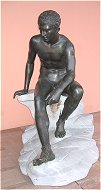MercuryMuseum Label: Chiurazzi description: Origin: Museo di Napoli |
Subject info:
The Mercury sculpture was discovered in 1758 at Herculaneum in the grounds of Villa dei
Papyri and kept in the Royal Palace of Portici. Later, in WW II it was captured by the
Germans, but came back to Naples in 1947.
This sculpture was the most celebrated work of art discovered from Herculaneum and Pompei in the 18th century.
Vesuvius:
As it gradually swallowed up an entire town, the volcanic mud of Vesuvius also preserved
an extraordinary wealth of Classical sculpture. At points the mud rose so gently as to
ooze over eggs without breaking them and fill rooms without disturbing the position of
their contents. Much was simply encased as it rested, hermetically sealed in mud as it
assumed its hardened form. Faced with such conditions, early excavators located but did
not fully uncover, the villa of the Papyri, and to this day it remains buried. But from
shafts dug down through the mud betwen 1750 and 1765 into this grand private estate, a
haul of some eighty pieces of art was lifted to the surface. Despite taking its name from
the copious rolls of papyrus found carbonized in its extensive library, the mud of the
villa gave up the largest private collection of sculptural art of the Classical tradition
found in any one ancient house.
Mercury:
Mercury is god of trade and profit, merchants and travelers, but originally of the trade
in corn. In later times he was equated with the Greek Hermes. He had a
temple in Rome near the Circus Maximus on the Aventine Hill which dates back to 495 BCE.
This temple was connected to some kind of trade fair. His main festival, the Mercuralia,
was celebrated on May 15 and on this day the merchants sprinkled their heads and their
merchandise with water from his well near the Porta Capena.
During the time of the Roman Empire the cult of Mercury was widely spread, especially
among the Celtic and Germanic peoples. The Celts have their Gaulish Mercury, and the
Germans identified him with their Wodan.
The attributes of Mercury are the caduceus (a staff with two intertwined snakes) and a
purse (a symbol of his connection with commerce). He is portrayed similarly to Hermes:
dressed in a wide cloak, wearing talaria (winged sandals) and petasus (winged hat).
Mercury is also known as Alipes ("with the winged feet").
